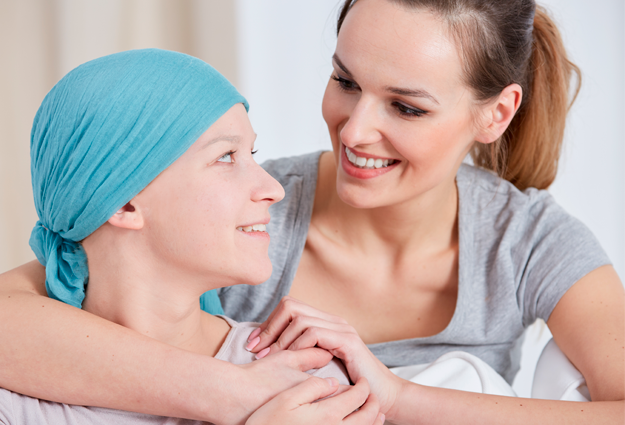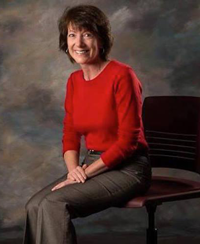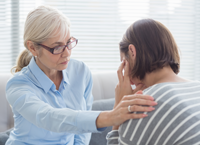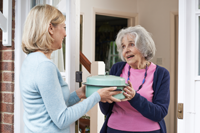
Putting patients on the path to cancer survivorship is about more than eliminating a tumor.
A well-defined survivorship program follows the patient's journey from diagnosis, through treatment, and beyond. It involves more than medical professionals, patient support volunteers, financial/insurance expertise, access to medical education, and wellness and holistic programs. However, the most critical voice you should include when you are putting together a cancer patient is that of the patient.
While holistic wellness programs are essential to good cancer survivorship program, there are a lot of basic concerns patients have.
Amy Regenstreiff is a patient advocate who has been battling her own rare form of cancer since 2001. I had the opportunity to see her speak in front of an attentive audience at the 2017 Annual Meeting of the  Society of Radiation Administrators in San Diego.
Society of Radiation Administrators in San Diego.
Amy told the audience “I used to go to the free yoga classes my center provided. People would talk to me because I was so open about the things that were going on in my life.
They would whisper to me, 'I love this yoga class, but I bought my medication and I can't pay my rent.' or say, ‘I have no idea what my next step is in cancer survivorship. I'm trying to be in a good mood, but I don't know if I should do chemo. I don't know if I should have a surgery. I just don't know what to do and I don't know who to talk to about it.’"
As a result of her personal experience and her conversations with other cancer patients, Amy recommends survivorship programs utilize a four-pronged approach to address the concerns patients have that can impede their journey to recovery: medical, psychological, social, finances.
Educating the Patient and Breaking through the Cancer Fog
Access to medical education is the first prong.
Patients don’t always know or comprehend what they’re going through, or why they may be getting chemotherapy over radiation therapy.
Amy explained how over the past sixteen years she has educated herself about her disease and the treatments. “I always ask my doctors about the things I’m researching and asking them ‘why this’ or ‘why that?’”
She keeps herself updated on the latest research and is not afraid to try new treatments if she thinks it will help. “I’m completely open about my medical record. I don’t care what people know about me; as long as doctors can learn from me and my condition then maybe that will help others.”
Joyce Chase is a Senior Account Manager here at Beekley and a breast cancer survivor. She was diagnosed 15 years ago when she went for her routine mammogram. The news was earth shattering for Joyce, her husband, and their two children; but Joyce started treatment with an admirable positive mental attitude. She was determined to face her cancer head-on and learn everything she could about it.
“I really appreciated the access to all the self-education resources they had at Bristol Hospital,” she explained. When Joyce was asked to be on the advisory committee during the design phase of the Beekley Center for Breast Health and Wellness Center, she suggested that they do something similar for the cancer center.
Joyce also told us that she was blessed to find a doctor who was very tapped into the up-to-date research.
 However, even with her take charge attitude and 25 years of experience and industry knowledge in the field of breast cancer detection and treatment, Joyce admits she sometimes had difficulty remembering all the details of her conversations with her doctors.
However, even with her take charge attitude and 25 years of experience and industry knowledge in the field of breast cancer detection and treatment, Joyce admits she sometimes had difficulty remembering all the details of her conversations with her doctors.
“It’s like they were talking to me but there was this ‘cancer fog’ over me. Thankfully my husband, Peter, had a great idea.
He told me he was going to get me a small notebook so that when we went for visits I could write down all the questions I had - all the questions from talking to mammographers, radiologists, and all the research I had done.” The notebook helped Joyce keep focused and allowed her to ask her physician all the questions she had about her wellness.
The greatest advocate the patient can have is themselves. A survivorship program needs to do more than treat the cancer. It needs to help patients break through the cancer fog.
Getting Patients Out of their Heads and Into Treatment
Amy’s second prong is focused on the patient’s psychological well-being and state of mind.
 For many patients learning more about cancer and their treatment can be frightening. Counseling for the individual patient and their families can play a critical role in survivorship.
For many patients learning more about cancer and their treatment can be frightening. Counseling for the individual patient and their families can play a critical role in survivorship.
If patients can be brought out of their “cancer fog,” they can pay more attention to fighting for their health.
Amy strongly recommended that patients talk about what they’re experiencing both emotionally and physically. And sometimes, counseling is not enough. Helping them connect with other cancer survivors who understand the experience of treatment and recovery can provide a positive future to push patients forward.
So Amy asks herself, "How do I get that cancer patient to get out of their heads? How do I get them out of their heads and into long-term cancer survivorship and help them create a life that they can live with?”
Joyce’s own experience echoed the importance of focusing on the positive. She told us, “If you have a positive outlook, you’re more likely to have a better outcome. I wanted to show my children that I wasn't curling up in a corner. Most people face tough things in life, at different times for different reasons. You know people don't always talk about it. It also helped that I have a strong and broad sense of humor. I named my wig ‘Betty’ and when I went shopping I would tell my friends ‘if I buy too much, I’ll just tell my husband it was Betty’s fault.”
Helping Patients Realize that Life Goes on With Cancer
Amy’s third prong is focused on the life patients live outside of their treatment.
A patient’s social life plays a critical role in their day to day tasks. Family, friends, and co-workers aren’t just an emotional support group. Being a shoulder to cry on is great…but sometimes you just need a friend to help you with the laundry.
 Amy recounted how a patient she worked with was struggling to manage all the aspects of her daily life. Amy sat down with her and created a grid: a list of things she needed, when she needed them, and who could help her. They reached out to her church, her friends, and family to arrange laundry, grocery shopping, meals, and rides for her child to school. She had 200 people sign up to help her.
Amy recounted how a patient she worked with was struggling to manage all the aspects of her daily life. Amy sat down with her and created a grid: a list of things she needed, when she needed them, and who could help her. They reached out to her church, her friends, and family to arrange laundry, grocery shopping, meals, and rides for her child to school. She had 200 people sign up to help her.
Amy also shared that patients should be prepared to see their social dynamic shift quickly for patients after diagnosis. Friends and family who were once there, suddenly disappear.
“A big thing in cancer survivorship, honestly, is people. Many cancer patients discuss among themselves how they feel they're abandoned by family members and friends.
After my initial diagnosis, a person I thought was my best friend, I never heard from again. I can honestly say that 99% of my friends since 2001 have changed. Not because I moved. Not because the basis of my personality has changed all the much. It's really because of cancer and some people just are not good at that. I teach people to let them go. I also teach them to bring in new people, that their life is not over, that there's still a chance that life is going to go on for many, many years and it's good to bring new people in to get your life moving forward.”
This is one more reason to involve patient volunteers in your survivorship program. No one understands life during and after cancer better than cancer survivor.
Joyce explained how her outlook was greatly impacted by her friendship with other survivors and why she became a volunteer as well.
“There were friends that brought me to events. A coworker took me to High Tea with other survivors. There were a lot of other great things like that; but having a survivor who can turn to you and say ‘Joyce, I’m ten years out without a recurrence. You’re going to be fine’ really bolstered my spirits - it was an entirely different level of support. You can ask survivors real questions - the tough questions you wouldn’t want your family to hear because you don’t want to scare them.”
Advocating for the Patient’s Right to Treatment
Amy’s fourth prong is what she calls “paperwork,” which is all things concerning finance and insurance. The best treatment in the world doesn’t help a patient if they can’t afford it or get to it. Insurance is often a tangled web and patients are expected to become overnight experts.
 “I cannot tell you how many times I’ve walked into a patient’s home and bumped into a wall of paperwork.” Amy said that she has argued with insurance companies on behalf of many patients. It’s so common, that navigating the complex healthcare system is almost a rite of passage for patients.
“I cannot tell you how many times I’ve walked into a patient’s home and bumped into a wall of paperwork.” Amy said that she has argued with insurance companies on behalf of many patients. It’s so common, that navigating the complex healthcare system is almost a rite of passage for patients.
This experience is all too familiar to Joyce. Her doctors recommended that they perform an MRI of both breasts to determine the right treatment for her. The insurance company refused to cover the exam at the time because it was too expensive and not viewed as necessary to her treatment. After her doctors gave up, Joyce got on the phone and fought for her healthcare.
“I told them ‘I'm recording this call. And if you don't approve me to have these MRIs and I find out that my treatment wasn't right, I'm holding you accountable.’” The insurer paid for the exams and Joyce received the treatment her doctors recommended.
“It was ridiculous. I’m already under all this stress. I shouldn’t have to fight with them for an exam. There were clear medical reasons that I needed it.”
Sometimes the issue is not with insurers, but rather logistics. Many patients, especially those in rural areas, are often faced with transportation challenges. While the patients' insurance may cover the exams and treatment, that won't do any good if the patient cannot physically get to the treatment facility.
Amy recounted how she overcame this challenge for one patient by partnering with a local business. “I founded a support group at Cedar Sinai in Los Angeles a few years ago and met a gentleman in his sixties.
He was going through a new type of chemo and couldn't drive and he couldn't get the medical van to take him back and forth. He did have a friend to drive him but neither of them had a car. I called a local rental car company and said, ‘This gentleman has Stage 4 cancer and needs chemo. What can you do for us about a car?’ For six months they gave him a car for $10 so for two days a week his friend could drive him back and forth.”
Planning Your Survivorship Program
There are quite a few good program models out there. Memorial Sloan Kettering Cancer Center, in particular, has a very comprehensive plan for cancer survivorship
However, the most effective model for your facility’s survivorship program will depend on your patient population. The American Society of Clinical Oncology also provides resources to help oncology providers implement or improve a survivorship program care in their practices
When your facility is putting together your cancer survivorship program, ask yourself these few key questions:
• What do our patients need for survivorship?
• How can we bring in the right experts and patient volunteers?
• Does our survivorship model cover all aspects of the patient's life?
Related articles:

Jonathan McCullough
Product Manager
